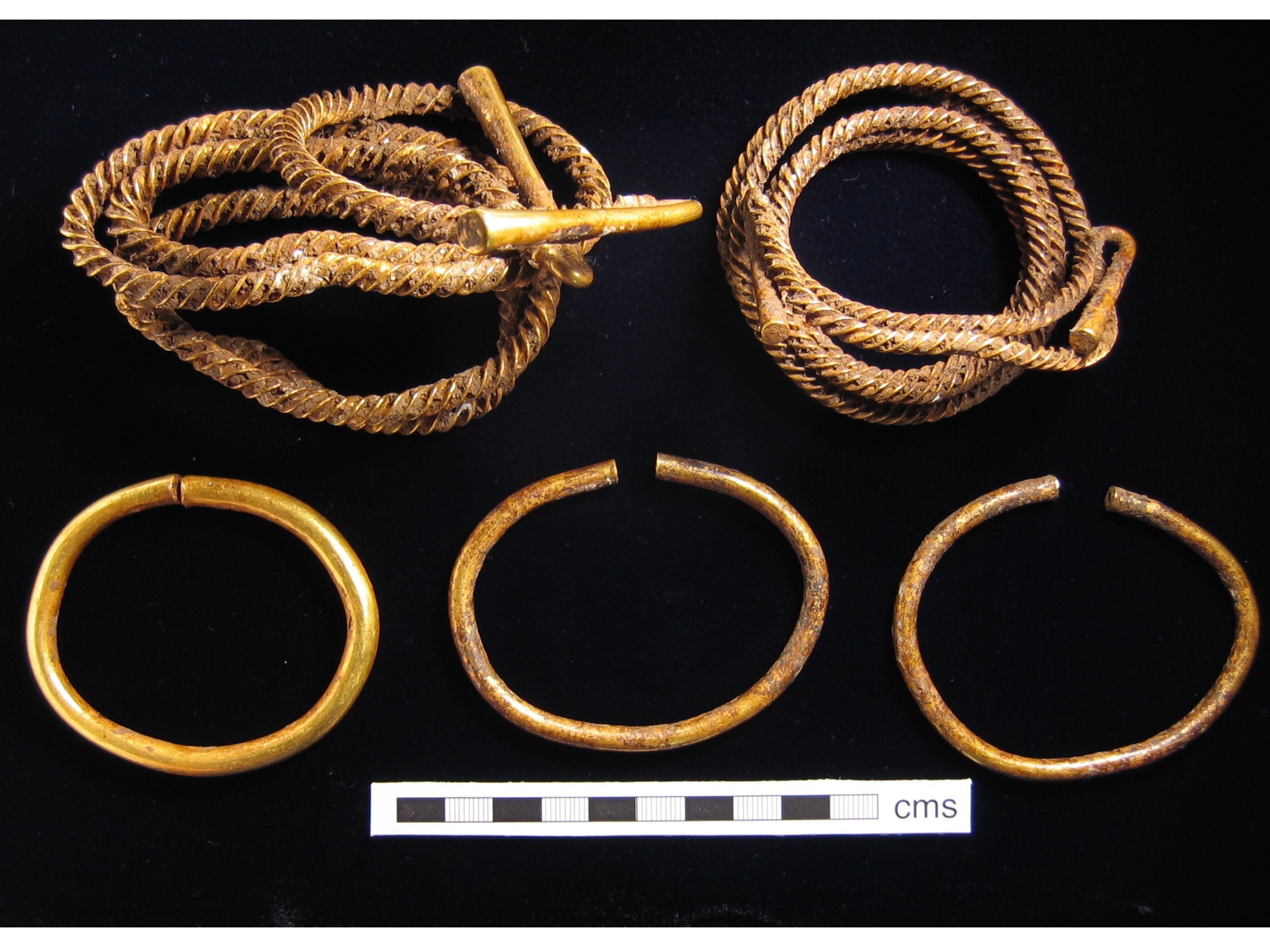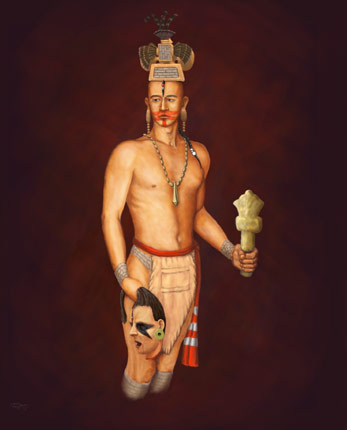|
Kalabubu
Kalabubu, sometimes spelled Kala bubu, is a torc (stiff circular necklace) worn by warriors of the Nias people, people of South Nias of North Sumatra, Indonesia. Kalabubu symbolizes triumph in warfare and heroism. Wearing a kalabubu was believed to protect the wearer from harm. Kalabubu is popularly known as the "headhunter's necklace"; historically only those who already decapitated the head of the enemy tribes are allowed to wear the kalabubu. Form and construction Kalabubu is circular in form with diameter between to . The thickness of the kalabubu differs with the center part wider and then gradually smaller at both ends. The shrinking ends are connected to form either a disk, either of brass or rarely of gold. The internal frame of a kalabubu is made out of an iron or brass wire which is tied at the end. The tying at the end is shaped like a disk. Disk-shaped slices of coconut shell (or sometimes turtle shell) are fitted around the internal brass frame. The disk are cut progr ... [...More Info...] [...Related Items...] OR: [Wikipedia] [Google] [Baidu] |
Nias People
Nias people are Austronesian people, Austronesian ethnic group native to Nias, an island off the west coast of North Sumatra, Indonesia. In the Nias language, the Nias people are known as Ono Niha, which means 'descendants of humans'. Nias island is known as ''Tanö Niha'', with ''Tanö'' meaning 'land' in the Nias language. The Nias people are a community that continues living within the norms and practices of their indigenous culture. The customary law of the Nias people is generally referred to as ''fondrakö'', which regulates all aspects of life from birth to death. Historical evidence of megalithic structures and stone carvings that are found in the interior of the island proved that ancient Nias people practiced megalith culture. The caste system is also recognized in Nias society, whereby the highest level out of the 12 levels in the Nias caste system is ''Balugu''. To reach this level of caste, one must be able to carry out big festivals by inviting thousands of people an ... [...More Info...] [...Related Items...] OR: [Wikipedia] [Google] [Baidu] |
Torc
A torc, also spelled torq or torque, is a large rigid or stiff neck ring in metal, made either as a single piece or from strands twisted together. The great majority are open at the front, although some have hook and ring closures and a few have mortice and tenon locking catches to close them. Many seem designed for near-permanent wear and would have been difficult to remove. Torcs have been found in Scythian, Illyrian, Thracian, Celtic, and other cultures of the European Iron Age from around the 8th century BC to the 3rd century AD. For Iron Age Celts, the gold torc seems to have been a key object. It identified the wearer—apparently usually female until the 3rd century BC, thereafter usually but not exclusively male—as a person of high rank, and many of the finest works of ancient Celtic art are torcs. Celtic torcs disappeared in the Migration Period, but during the Viking Age torc-style metal necklaces, mainly in silver, came back into fashion. Similar ne ... [...More Info...] [...Related Items...] OR: [Wikipedia] [Google] [Baidu] |
North Sumatra
North Sumatra () is a Provinces of Indonesia, province of Indonesia located in the northern part of the island of Sumatra. Its capital and largest city is Medan on the east coast of the island. It borders Aceh to the northwest, Riau to the southeast, West Sumatra to the south, the Indian Ocean to the west, and the Strait of Malacca (with a maritime border with Malaysia) to the east. With a 2020 population around 14.8 million and a mid-2024 estimate around 15.6 million, North Sumatra is Indonesia's fourth most populous province and the most populous province outside of Java, Java Island. At , North Sumatra is the third-largest province in area on the island of Sumatra behind South Sumatra and Riau. Major ethnic groups include the Malay Indonesian, Malay, native to the east coast; several Batak groups, indigenous to the west coast and central highlands; the Nias people of Nias, Nias Island and its surrounding islets; and Chinese Indonesian, Chinese, Javanese people, Javanese, an ... [...More Info...] [...Related Items...] OR: [Wikipedia] [Google] [Baidu] |
Indonesia
Indonesia, officially the Republic of Indonesia, is a country in Southeast Asia and Oceania, between the Indian Ocean, Indian and Pacific Ocean, Pacific oceans. Comprising over List of islands of Indonesia, 17,000 islands, including Sumatra, Java, Sulawesi, and parts of Borneo and New Guinea, Indonesia is the world's largest archipelagic state and the List of countries and dependencies by area, 14th-largest country by area, at . With over 280 million people, Indonesia is the world's List of countries and dependencies by population, fourth-most-populous country and the most populous Islam by country, Muslim-majority country. Java, the world's List of islands by population, most populous island, is home to more than half of the country's population. Indonesia operates as a Presidential system, presidential republic with an elected People's Consultative Assembly, legislature and consists of Provinces of Indonesia, 38 provinces, nine of which have Autonomous administrative divisi ... [...More Info...] [...Related Items...] OR: [Wikipedia] [Google] [Baidu] |
Neck Torc MET TR
The neck is the part of the body in many vertebrates that connects the head to the torso. It supports the weight of the head and protects the nerves that transmit sensory and motor information between the brain and the rest of the body. Additionally, the neck is highly flexible, allowing the head to turn and move in all directions. Anatomically, the human neck is divided into four compartments: vertebral, visceral, and two vascular compartments. Within these compartments, the neck houses the cervical vertebrae, the cervical portion of the spinal cord, upper parts of the respiratory and digestive tracts, endocrine glands, nerves, arteries and veins. The muscles of the neck, which are separate from the compartments, form the boundaries of the neck triangles. In anatomy, the neck is also referred to as the or . However, when the term ''cervix'' is used alone, it often refers to the uterine cervix, the neck of the uterus. Therefore, the adjective ''cervical'' ca ... [...More Info...] [...Related Items...] OR: [Wikipedia] [Google] [Baidu] |
Headhunting
Headhunting is the practice of hunting a human and collecting the severed head after killing the victim. More portable body parts (such as ear, nose, or scalp) can be taken as trophies, instead. Headhunting was practiced in historic times across parts of Europe, East Asia, Oceania, Southeast Asia, South Asia, Mesoamerica, South America, West Africa, and Central Africa. The headhunting practice has been the subject of intense study within the anthropological community, where scholars try to assess and interpret its social roles, functions, and motivations. Anthropological writings explore themes in headhunting that include mortification of the rival, ritual violence, cosmological balance, the display of manhood, cannibalism, dominance over the body and soul of his enemies in life and afterlife, as a trophy and proof of killing (achievement in hunting), show of greatness, prestige by taking on a rival's spirit and power, and as a means of securing the services of the vi ... [...More Info...] [...Related Items...] OR: [Wikipedia] [Google] [Baidu] |
South Nias Regency
Nias Selatan (South Nias) Regency is a regency in North Sumatra province, Indonesia, created on 25 February 2003 by the division of the existing Nias Regency. The regency covers a land area of 2,487.99 square kilometres and according to the 2010 census had a population of 289,708;Biro Pusat Statistik, Jakarta, 2011. the 2020 Census showed a population of 360,531,Badan Pusat Statistik, Jakarta, 2021. while the official estimate for mid 2023 was 368,834.Badan Pusat Statistik, Jakarta, 26 September 2024 (sum of 35 individual Katalogue reports detailed in references 4 to 38) Its administrative centre is the port of Teluk Dalam. Apart from the southern portion of Nias Island, the regency also includes the smaller Batu Islands (Pulau Pulau Batu) to the south, lying between Nias and Siberut; these islands occupy nearly half of the land area of the Regency, but have just 9% of its population. Administrative districts The regency was divided into eighteen Districts of Indonesia, distric ... [...More Info...] [...Related Items...] OR: [Wikipedia] [Google] [Baidu] |
Omo Sebua
The Omo sebua is a traditional house style of the Nias people from Nias island, Indonesia. They are built only for the houses of the village's chiefs. Situated in the centre of a village, ''omo sebua''s are built on massive ironwood Deep foundation, piles and have towering roofs. Nias culture, with its frequent inter-village warfare, has made the design of ''omo sebua'' impregnable to attack. The houses' sole access is through a narrow staircase with a small trap door above. The steeply pitched roofs can reach 16 metres (50 feet) in height. Apart from a strong defence against enemies, ''omo sebua'' has proven earthquake resistance. Background Nias (, Nias language: ''Tanö Niha'') is a rugged island 140 km off the mainland port of Sibolga at the western coast of Sumatra, separated by the Mentawai Strait. Nias is part of the North Sumatra province with Gunungsitoli as its administrative center. The island covers an area of 4,771 km2; the largest of its 131 chain of islands ... [...More Info...] [...Related Items...] OR: [Wikipedia] [Google] [Baidu] |
Folk Costumes
Folk costume, traditional dress, traditional attire or folk attire, is clothing of an ethnic group, nation or region, and expresses Cultural identity, cultural, Religious identity, religious or national identity. An ethnic group's clothing may also be called ethnic clothing or ethnic dress. Traditional clothing includes everyday and formal wear. The word "costume" in this context is sometimes considered pejorative, as the word has more than one meaning, and thus "clothing", "dress", "attire" or "regalia" can be substituted without offense. Following the rise of romantic nationalism in parts of Europe, pre-industrial peasantry came to serve as ideals for genuinity and desirability. Garments evoking peasant dress were made from narrow cloth, traditional pre-industrial textiles. In regions where Western dress codes, Western dress styles are common, traditional garments are often worn during special events or celebrations. International events may cater to non-Western attendees with ... [...More Info...] [...Related Items...] OR: [Wikipedia] [Google] [Baidu] |






